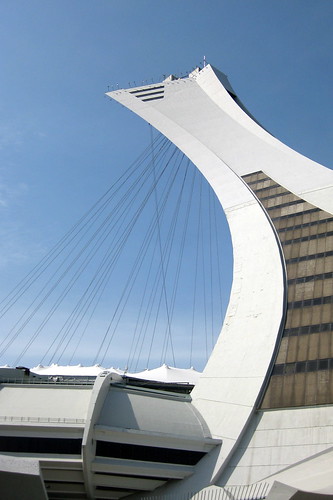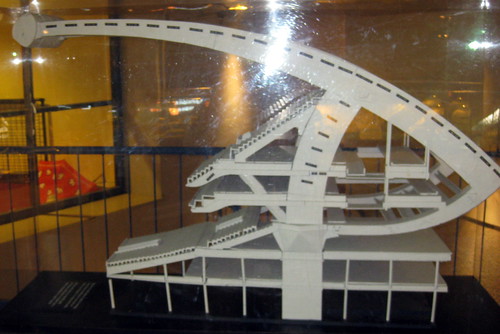Check out these Montreal Expos images:
Montréal – Hochelaga-Maisonneuve: Le Stade Olympique de Montréal

Image by wallyg
Le Stade Olympique de Montréal (Montreal Olympic Stadium) was built as the main venue for the 1976 Summer Olympics, and subsequently became the home ballpark of Major League Baseball’s Montreal Expos from 1977 until the franchise was moved to Washington, D.C. after the 2004 season, and Canadian Football League teams. The stadium hosted the opening and closing ceremonies, track and field, soccer finals and some equestrian events for the 1976 Games. The Olympic swimming pool was located under the tower, and the Olympic Velodrome (since converted to the Biodôme) were situated at the base of the tower. Olympic Stadium has served as a home to the CFL’s Montreal Alouettes, NASL’s Montreal Manic, WLAF’s Montreal Machine, and has hosted the CFL’s Grey Cup.
"The Big O", designed by French architect Roger Tailibert, was to feature a retractable roof, which would be opened and closed by La tour de Montréal (Montreal Tower), the tallest inclined structure in the world at 175-metres, on a 45-degree angle. The tower, a member of the World Federation of Great Towers, offers visitors a 360-degree panaroma at the Observatoire de la Tour de Montréal (Montreal Tower Observatory), accessible via a 2-minute funicular-ride. The bi-level funicular, which travels 2.8 metres per second, accommodates up to 76 people per ride.
The stadium was not completed in time for the games. Cost and construction overruns resulting from the unusual design, coupled with labor strikes, left the stadium without a tower or roof for the opening ceremonies. The 65-ton roof languished in a warehouse in France until 1982. It wasn’t until 1987 that both the tower and the roof, made of over 5,574 square-metres of Kevlar, were completed, and until 1988 that the roof could be retracted. And even then, the roof could not be used in winds greater than 40 km/hr. Initial projections estimated the cost of the stadium at C4 million, but costs reached C4 million when the unfinished stadium opened. The City of Montréal did not finish paying off the stadium until 2006, when total costs of the "Big Owe" were estimated to have reached C.4 billion.
Montréal – Hochelaga-Maisonneuve: Le Stade Olympique de Montréal Maquette

Image by wallyg
This working model of le Stade Olympique de Montréal was used as an assembly guide. Each element prefabricated in the plant bears a number corresponding to a specific location.
Le Stade Olympique de Montréal (Montreal Olympic Stadium) was built as the main venue for the 1976 Summer Olympics, and subsequently became the home ballpark of Major League Baseball’s Montreal Expos from 1977 until the franchise was moved to Washington, D.C. after the 2004 season, and Canadian Football League teams. The stadium hosted the opening and closing ceremonies, track and field, soccer finals and some equestrian events for the 1976 Games. The Olympic swimming pool was located under the tower, and the Olympic Velodrome (since converted to the Biodôme) were situated at the base of the tower. Olympic Stadium has served as a home to the CFL’s Montreal Alouettes, NASL’s Montreal Manic, WLAF’s Montreal Machine, and has hosted the CFL’s Grey Cup.
"The Big O", designed by French architect Roger Tailibert, was to feature a retractable roof, which would be opened and closed by La tour de Montréal (Montreal Tower), the tallest inclined structure in the world at 175-metres, on a 45-degree angle. The tower, a member of the World Federation of Great Towers, offers visitors a 360-degree panaroma at the Observatoire de la Tour de Montréal (Montreal Tower Observatory), accessible via a 2-minute funicular-ride. The bi-level funicular, which travels 2.8 metres per second, accommodates up to 76 people per ride.
The stadium was not completed in time for the games. Cost and construction overruns resulting from the unusual design, coupled with labor strikes, left the stadium without a tower or roof for the opening ceremonies. The 65-ton roof languished in a warehouse in France until 1982. It wasn’t until 1987 that both the tower and the roof, made of over 5,574 square-metres of Kevlar, were completed, and until 1988 that the roof could be retracted. And even then, the roof could not be used in winds greater than 40 km/hr. Initial projections estimated the cost of the stadium at C4 million, but costs reached C4 million when the unfinished stadium opened. The City of Montréal did not finish paying off the stadium until 2006, when total costs of the "Big Owe" were estimated to have reached C.4 billion.
